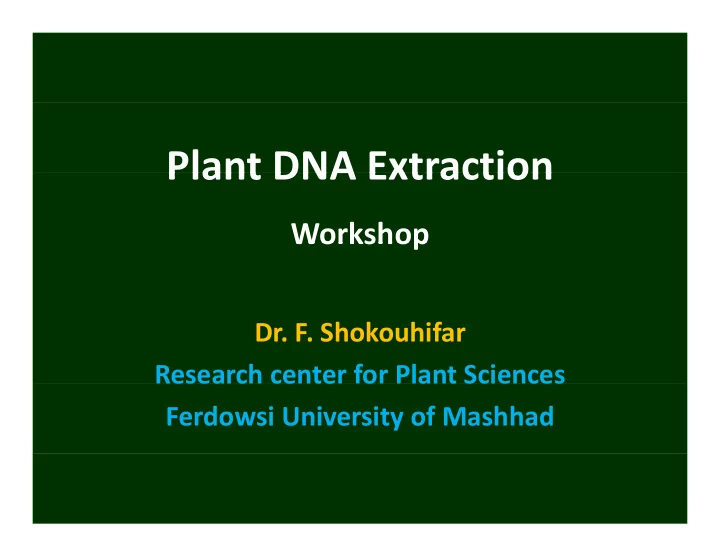

Plant DNA Extraction Plant DNA Extraction Workshop Workshop Dr. F. Shokouhifar Research center for Plant Sciences Research center for Plant Sciences Ferdowsi University of Mashhad
The first step in most molecular biology studies • Detection: – PCR, PCR – Hybridization, • Manipulation: – Cloning, – Transformation, • Sequencing Sequencing • etc
DNA extraction • Target nucleic acid DNA RNA DNA, RNA – • Source organism Plant (In our case ), Human, bacterial, etc. – • Starting material (tissue, leaf, seed, processed material, etc.) – • Desired results Desired results (yield, purity, purification time required, etc.) – • Downstream application (PCR, cloning, labeling, blotting, etc.) –
Source organism Source organism • Eukaryotic cells • Eukaryotic cells – Chromosomal DNA – Mitochondrial DNA Mit h d i l DNA – Chloroplast DNA • Prokaryotic cells – Chromosomal DNA – Plasmid DNA
plasmids
The cell barriers for Plant DNA extraction
The main Plant DNA Extraction steps The main Plant DNA Extraction steps • Extraction: – Lysis of the cell wall, y , – Disturb the cell membranes, – Inactivation of cellular nucleases Inactivation of cellular nucleases, – Separation cellular debris, • Purification: • Purification: – Remove contaminants from nucleic acids
Extraction methods: cell lysis Extraction methods: cell lysis The lysis procedure should be a compromise of The lysis procedure should be a compromise of gently and rigorously methods – To preserve the target nucleic acid – To disrupt the complex starting material
Common lysis procedures Common lysis procedures • • Mechanical disruption Mechanical disruption – (e.g. grinding, hypotonic lysis) • • Chemical treatment Chemical treatment – detergent to solubilise cell membranes – chaotropic salts, likes Guanidine Hydro chaotropic salts, likes Guanidine Hydro Chloride (GuHCl), Sodium dodecyl sulfate, denature proteins • • Enzymatic digestion – (e.g. proteinase K, )
Disruption of the cellular membrane p by detergents
Purification methods Purification methods • Solvent extraction – phenol and chloroform to remove proteins – isopropanol or ethanol to concentrate nucleic acids DNA acids DNA • Chromatography – Gel filtration, ion exchange, selective adsorption, Gel filtration, ion exchange, selective adsorption, • Centrifugation – ultracentrifugation in self ‐ forming CsCl gradients • Affinity separation – magnetic separation
Some of Plant DNA extraction methods S f Pl t DNA t ti th d • Dellaporta protocol (Dellaporta et al. 1983), • CTAB protocol (Murray and Thompson,1980), CTAB t l (M d Th 1980)
Dellaporta method Dellaporta method First developed by Dellaporta et al in 1983 First developed by Dellaporta et al. in 1983, – Large scale DNA L l DNA – Pure DNA – Reliably DNA for hybridization methods likes RFLP, southern analysis, etc.
Dellaporta method steps Dellaporta method steps • Grinding: – Grinding freeze leaves in N2 by mortar and pestle, • EXTRACTION: – Tris buffer to set pH at 8 to stabilize DNA – EDTA to chalet Mg ++ & Ca ++ and inhibits nucleases – High NaCl concentration to Salting out Histone High NaCl concentration to Salting out Histone proteins – SDS as detergents to disrupt cell membrane – Heat at 60 ⁰ C to help the detergent in its H t t 60 ⁰ C t h l th d t t i it action
Dellaporta method Dellaporta method • Purification: Purification: – Potassium acetate to precipitate polysaccharides, polysaccharides, – Centrifuge and Miracloth filtering to remove cell debris, remove cell debris, – Phenol/Chloroform to remove proteins – Cooled isopropanol and centrifuge to Cooled isopropanol and centrifuge to concentrate and precipitate DNA – TE buffer to resolve precipitated DNA TE buffer to resolve precipitated DNA
CTAB extraction and purification method h • The CetylTrimethylAmmonium Bromide (CTAB) y y ( ) protocol (Murray and Thompson,1980), • Appropriate for the extraction and purification of DNA from plants and plant derived foodstuff, • suitable for the elimination of polysaccharides and polyphenolic compounds, p yp p , • Results DNA with high purity and quality scale
CTAB extraction and purification method h • Lysis – homogenised sample – Ionic detergent (CTAB) • Extraction • Extraction – Form CTAB ‐ DNA insoluble complex – In this step, polysaccharides, phenolic compounds, proteins and other cell lysates d t i d th ll l t dissolved in the aqueous solution are separated from the CTAB nucleic acid complex – The DNA complex is solubilised by raising the salt The DNA complex is solubilised by raising the salt concentration • Precipitation – precipitated with ethanol or isopropanol.
Some inhibitors of the PCR process Some inhibitors of the PCR process
Some DNA extraction tools • Tissue grinders • Bead Micro tube Homogenizer • Automated DNA extraction system Automated DNA extraction system • FTA Cards
Tissue grinders Tissue grinders
BeadBug™ Microtube Homogenizer BeadBug Microtube Homogenizer • mixing, lysis, grinding or homogenization mixing, lysis, grinding or homogenization • avoids cross contamination between samples • Homogenize 1 ‐ 3 samples simultaneously Homogenize 1 3 samples simultaneously
Bead Ruptor Homogenizer Bead Ruptor Homogenizer
Homogenized samples Homogenized samples
Automated DNA extraction system Automated DNA extraction system
FTA TM Nucleic Acid Collection, Storage and Purification f FTA Cards contain chemicals that: – lyse cells, – denature proteins – protect nucleic acids from damages: • nucleases • oxidative • UV
Advantages and benefits Advantages and benefits Capture nucleic acid in one easy step • Captured nucleic acid is ready for downstream applications in less than 30 • minutes DNA collected on FTA Cards is preserved for years at room temperature • FTA Cards are stored at room temperature before and after sample p p • application, reducing the need for laboratory freezers Suitable for virtually any cell type • Indicating FTA Cards change color upon sample application to facilitate • handling of colorless samples
a device for DNA capturing by the FTA Cards
Thanks for your attention Thanks for your attention Lets tea time Lets tea time
Recommend
More recommend